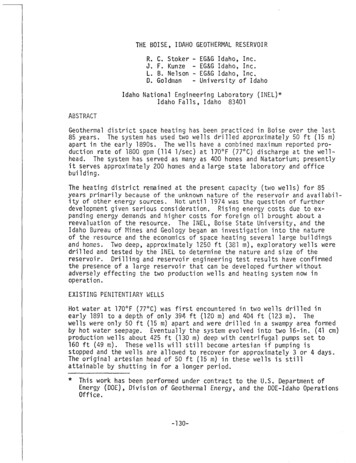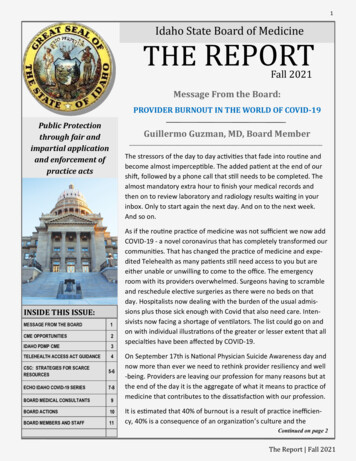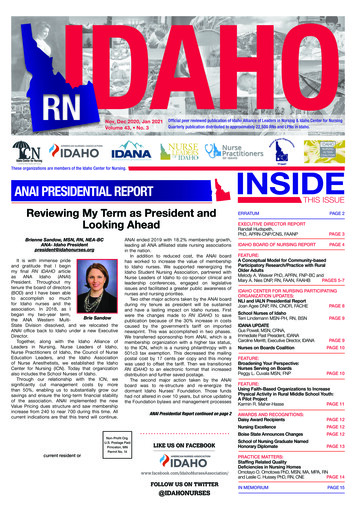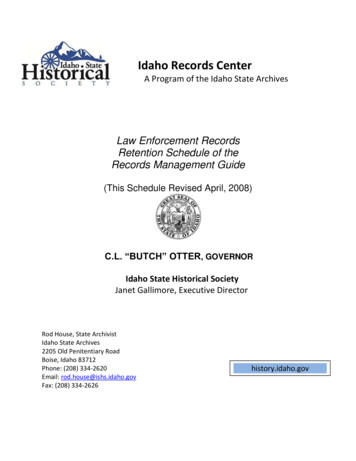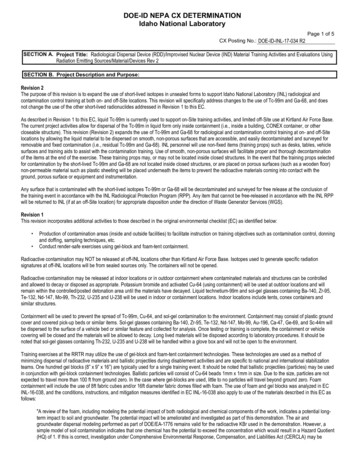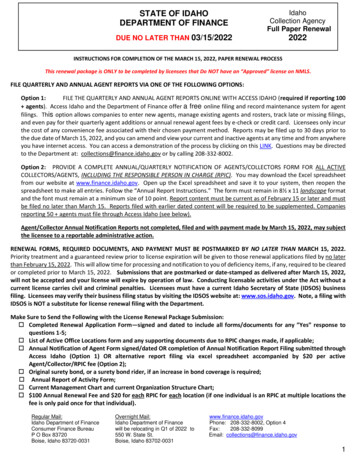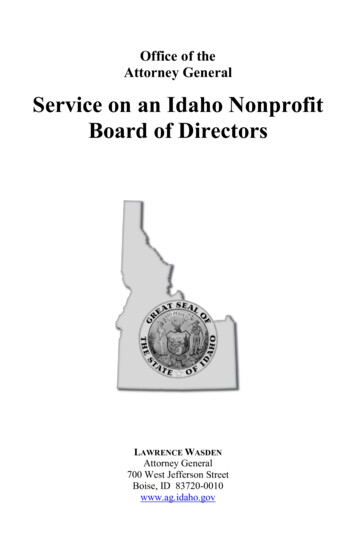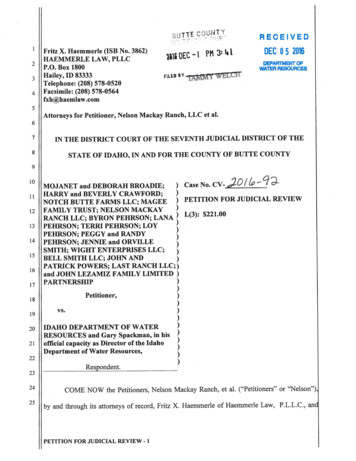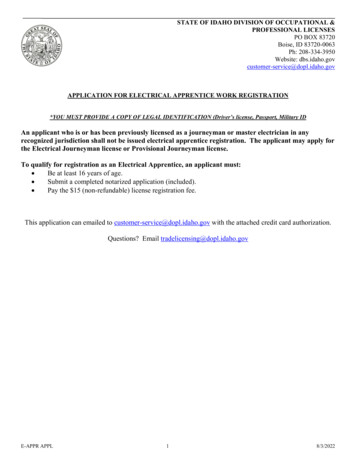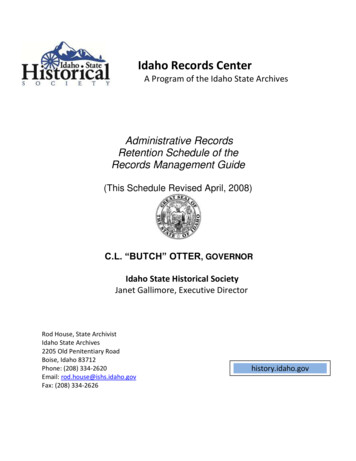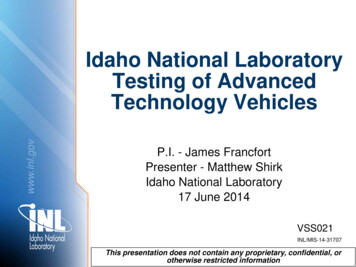
Transcription
www.inl.govIdaho National LaboratoryTesting of AdvancedTechnology VehiclesP.I. - James FrancfortPresenter - Matthew ShirkIdaho National Laboratory17 June 2014VSS021INL/MIS-14-31707This presentation does not contain any proprietary, confidential, orotherwise restricted information
OverviewTimelineThe Advanced Vehicle Testing Activity(AVTA) is an annually funded DOEactivityBudgetFY 2013 project funding 1.8 millionFY 2014 project funding 1.05MBarriersBarriers addressed High risk to develop and purchaseplug-in electric vehicles (PEV) andcharging infrastructure PEV infrastructure requirements andimpacts are not yet understood Development of codes andstandards for products and testing isrequiredPartners Intertek Testing Services – AVTAtesting partner NETL, ORNL, ANL Ford, GM, OnStar, Chrysler, Nissan,ECOtality, Intertek, ChargePoint,EPRI, AeroVironment, NYC TLC viavehicle and infrastructure demos Idaho National Laboratory – Lead
ObjectivesAVTA’s objective is to support DOE’s goal of petroleum reduction and energysecurity by: Performing low-cost testing and demonstrations of advanced technologyvehicles and fueling infrastructure to:– Identify the real-world potential of the technology for petroleumdisplacement– Verify return on investment of DOE-funded technology development Providing results and lessons learned to a broad range of stakeholders,including:– DOE modelers and target setters to improve model validity– R&D organizations to reduce risk of product development decisions– Electric utilities, policy makers, and government agencies to guide theirinfrastructure requirements planning and impact assessment– Standards development organizations to support the development ofcodes and standards– Fleet managers and private consumers to assist them in making vehicleand infrastructure purchase, deployment, and operating decisions thatminimize the overall cost of ownership
FY13 & FY14 MilestonesDateMilestoneStatus9/30/2013 Test two new HEV models.Complete9/30/2013 Collect data on all Nissan Leaf taxi cabsdeployedComplete9/30/2013 Collect data on 100 Volts and 100 Ramsfor 1 million milesComplete12/31/2013 Post testing reports and fact sheets on AVTA Completewebsite, report status3/3/1/2014 Post testing reports and fact sheets on AVTA Completewebsite, report status6/30/2014 Post testing reports and fact sheets on AVTA On-Trackwebsite, report status9/30/2014 Post testing reports and fact sheets on AVTA On-Trackwebsite, report status
Approach/Strategy AVTA testing procedures are established for each new technology based on:– Existing standard test procedures– Recommendations from fleet managers and subject matter experts fromindustry and other national laboratories AVTA test procedures are published and strictly followed to reduce testinguncertainties Depending on technology and capabilities, vehicles and EVSE are tested via:– Laboratory bench testers (battery packs, EVSE)– Closed test tracks and dynamometers– On-road captive fleet testing– Vehicle and infrastructure demonstrations by independent fleets andprivate consumers Different test methods are used to balance testing control / repeatability,sample size, and costs
Approach/Strategy continued Vehicle testing results are published to document:– Real-world vehicle fuel economy and electricity consumption as a result ofdriver behavior and external conditions– Traction battery pack capacity reduction as a result of vehicle use andconditions– Vehicle life-cycle costs EVSE testing results are published to document efficiency of charginginfrastructure technologies as a result of power level and product design Vehicle and infrastructure demonstration results are published to document– Vehicle fuel economy and electricity consumption as a result of driving andcharging behavior– Infrastructure use and electricity demand
Approach/Strategy continued Testing and demonstration results are presented in numerous ways, including:– To auto and electric utility industry representatives via DOE technical teammeetings (VSATT, GITT, EESTT, MTT)– Direct meetings with auto OEMs, federal/state/local agencies, NGOs anduniversities– Conferences, Clean Cities webinars, and other public venues– Via the EERE VTO and INL websites Publication of testing and demonstration results addresses barriers by– Lowering or avoiding cost by improving the product development processand helping end consumers make wise purchase, deployment, andoperating decisions– Verifying results of DOE-funded technology development to prevent wasteand drive future decisions– Helping infrastructure planners define infrastructure deploymentrequirements– Providing input to codes and standards development and validationprocess
Approach/Strategy continued AVTA is conducted primarily by INL and Intertek Testing Services NorthAmerica, with dynamometer testing by ANL and ORNL Testing activities, from individual EVSE tests to large-scale vehicle andinfrastructure demonstrations, are made possible by contributions from amultitude of partners – hundreds of organizations and thousands of individualparticipants to date Test methods, quality and efficiency of data collection, and cost of testing havebeen continuously improving since 1993
Vehicle Testing Accomplishments59 AVTE Vehicles Tested This YearPurchase Vehicle (4 of each model)Baseline Traction Battery TestingInstall On-Board Data Logger (all cars)4,000 Miles for Break-InTrack Performance and Coast Down Testing (one each model)Dynamometer Testing (one each model)Data Collection During Fleet Operation (all cars)Traction Batteries or Components3 Interim TestsEnd-of-test Component and Performance EvaluationEV end-of-test:60,000 MilesPHEV end-of-test:195,000 MilesHEV, ICE end-of-test: 195,000 Miles9
Vehicle Testing Accomplishments (cont.) HEV Models: 2 completed, 4 begin AVTE fleet testing (FY 13 Milestone)VehicleBaseline track anddyno testing2011 Honda CRZ (parallel mild HEV)Prior year2011 Hyundai Sonata Hybrid(parallel full HEV)2013 Chevrolet Malibu Eco(BAS mild HEV)Prior yearCompleteBattery Test2/2 TestsComplete2/2 TestsComplete2/5 TestsComplete2/5 TestsCompleteFleet mileageaccumulationVehiclesample sizeMiles target(per vehicle)Complete2160,000Complete2160,00046% Complete4195,00024% Complete4195,0002013 Honda Civic HybridComplete2013 Ford C-Max HybridComplete1/5 TestsComplete6% Complete4195,0002014 Volkswagen Jetta HybridComplete1/5 TestsComplete5% Complete4195,000 PHEV Models: 1 continue, and 4 begin AVTE fleet testingBaseline track anddyno testingBattery TestFleet mileageaccumulationVehiclesample sizeMiles target(per vehicle)2011 Chevrolet VoltPrior year2/5 TestsComplete33% Complete2195,0002013 Chevrolet VoltComplete2/5 TestsComplete27% Complete4195,0002013 Toyota Prius Plug-InComplete25% Complete4195,0002013 Ford C-Max EnergiComplete5% Complete4195,0002013 Ford Fusion EnergiOn Schedule2% Complete4195,000Vehicle2/5 TestsComplete1/5 TestsComplete1/5 TestsComplete
Vehicle Testing Accomplishments (cont.) BEV Models: 1 continuing, 4 begin AVTE fleet testingVehicleBaseline track anddyno testing2011 Nissan LeafPrior year2012 Mitsubishi iComplete2013 Nissan LeafComplete2013 Ford Focus EVOn Schedule2014 Smart EDOn ScheduleBattery Test2/5 TestsComplete1/5 TestsComplete1/5 TestsComplete1/5 TestsComplete0/5 TestsCompletedFleet mileageaccumulationVehiclesample sizeMiles target(per vehicle)51% Complete260,00014% Complete260,0006% Complete460,0001% Complete460,0000% Complete160,000Fleet mileageaccumulationVehiclesample sizeMiles target(per vehicle)24% Complete4195,00022% Complete4195,000 ICE Models: 2 begin AVTE fleet testingVehicle2012 Honda Civic CNG2013 Volkswagen Jetta TDIBaseline track andComponent Testdyno testing2/5 TestsCompleteCompleteCompleteNA
Battery Testing AccomplishmentsTraction battery capacity testing at beginning, 3interim points and completion of fleet mileageaccumulation Battery testing results-to-date published for––––––––––(4) 2013 Chevrolet Malibu Eco(4) 2013 Chevrolet Volt(4) 2013 Toyota Prius Plug-In(3) 2013 Ford C-Max Energi(4) 2013 Ford C-Max Hybrid(2) 2012 Mitsubishi i(4) 2013 Nissan Leaf(4) 2013 Ford Focus EV(4) 2013 Honda Civic Hybrid(4) 2013/2014 VW Jetta Hybrid Five battery test points through operationallow linkages between battery changes andoperating conditions, vehicle usage Leverages vehicle testing program’s fleetmileage accumulation
Battery Testing Accomplishments (cont.)DC Fast Charging Effect on Battery Life and Vehicle PerformanceThis project is fully detailed in VSS131 Baseline laboratory and track testing of 4 vehicles/battery packscompeted, lab cycling of 2 packs underway Battery tests performed after 10,20,30,40, and 50k miles of on-roadtesting Project results will provide the public with unprecedentedunderstanding of the impact of high charge power on battery life
Vehicle Demonstration Accomplishments2013 Ford C-Max Energi Fleet Demo Quarterly and summary results-to-dateINL reports published online Reporting Metrics– 2 Vehicles– 20,050 Miles @ 41 MPG 3853 Charge Depleting TripMiles (20%) @ 59 MPG2011 Chevrolet Volt Fleet Demo Quarterly and summary results-to-dateINL reports published online Reporting Metrics (FY13 Milestone)– 150 Vehicles– 3,531,534 Miles 1,667,196 EV Miles (47%)
Vehicle Demonstration AccomplishmentsChrysler Ram PHEV Demo Monthly and summary results-to-date INL reportspublished online Phase 1 data reporting – previous years– July 2011 – September 2012– 111 Vehicles/1,039,138 Miles– (FY13 Milestone) Phase 2 data reporting– November 2013 – March 2014– 23 Vehicles/114,018 Miles
Vehicle Demonstration AccomplishmentsNYC EV Taxi Pilot INL Data collection from Nissan Vehicle driving and charging data from 62012 Nissan Leaf Taxis (FY 13 Milestone) New York City Taxi & Limousine Commission(NYC TLC) Taxi meter data INL merges, analyzes data, providse monthlyreporting to Nissan, NYC Taxi and LimousineCommission NYC Taxi and Limousine Commission releasedTake Charge: A Roadmap to Electric New York CityTaxis leveraging demonstration reportingCredit: NYC Taxi & Limousine CommissionPhoto Credit: Nissan North America
Infrastructure Demonstration AccomplishmentsChargePoint America Provides information about ARRA fundedinfrastructure deployment and usage 4,647 AC L2 Ports in 9 regions in Dec 2013 INL published quarterly reports and mapsonline from 5/2011 through 12/2013Public infrastructure utilizationvaries geographically due to:- Vehicle population- Travel needs and routines- Local culture
Infrastructure Demonstration AccomplishmentsNYSERDA EVSE Demonstration Program INL collecting data from EVSE deployed in New York State Developing reporting in conjunction with NYSERDA and Energetics– Public reporting– Build on EV project reporting– Current data 228 EVSE, 345 ports. Diverse EVSE and attributes– 6 EVSE Mfg.– 4 Data providers– Location type, access type, signage– Truck ChargingPhoto Credit - NYSERDA
Demonstration AccomplishmentsResults from infrastructure and vehicle demos requested by a multitudeof organizations, including: Electric utilities seeking input on rate design, advice filings to PUCs EVSE manufacturers seeking insights into valued product features, businessmodel development Federal, state, and local agencies involved in infrastructure planning, such asDOT, California air quality management districts, DOE Clean Cities coalitions Auto manufacturers seeking to validate travel and charging behaviorassumptions Universities and private research organization collaboration
Codes and Standards Support AccomplishmentsProvide input from testing & evaluation to support standards development NFPA PEV Battery Hazards Project Best Practices for Emergency Response to Incidents InvolvingElectric Vehicles Battery Hazards: A Report on Full-Scale TestingResults technical report published NIST U.S. National Work Group on Measuring Devices for ElectricVehicle Fuel and Sub-Metering SAE J2894 Power Quality Requirements for Plug-In Electric VehicleChargers committee SAE J2954 Wireless Charging of Electric and Plug-in Hybrid Vehicles Support test procedure development– Test results using draft procedures– System tolerance,response to debris– Evaluated mock floor pan fixture, compare open air, on-vehicle
Federal Fleet Outreach AccomplishmentsFEMP fleet PEV suitability project Collected usage data from conventional vehicles in federal fleets Reporting results of analysis as it applies for each fleet’s mission Golden Gate NRA, Fort Vancouver NRA reports completed Agency Analyses in progress: (3) NPS, (3) NASA, (2) VA,(1) DHS, and (1) NIHDoD / DOE MOU Microclimate base study – Electric Vehicle Preparedness Joint Base Lewis McChord Candidate bases for evaluation Vehicle data logging, PEV suitability Infrastructure support analysis Purpose is to reduce fleets’ risk with advanced vehicle andinfrastructure purchase, deployment, and operating decisions
Address Previous Year Review Comments The reviewer observed that the presenter noted a lack of confidence in understanding the lifecycleperformance of EV batteries under normal driving conditions. The reviewer suggested that if this wastrue, that the INL study ought to identify specific areas of concern and suggest specific pathways toresolve the concerns.– Updated testing procedures incorporate continuous data logging through the life of a testvehicle. This information, combined with five laboratory battery tests throughout the vehicle lifeallow battery performance changes at mileage intervals to be linked to conditions the vehiclewas subjected to (i.e. heat, fast charge, frequent charging, little charging, etc). Additionally,performance changes in real-world operating conditions through the duration of vehicle testing(EV range, fuel economy, etc) can also be better attributed to battery degradation. The resultsof this testing feed into battery technical working groups including the national labs, DOE, andvehicle OEMs via U.S. Advanced Battery Consortium. USABC’s feedback is considered whilecontinuously improving testing methods to ensure the data products are providing value. The reviewer indicated that a more targeted effort in bringing this voluminous data stream down to adigestible level across this vehicle class is warranted. The reviewer added that stating thatcontinuation of objectives reinforces no change other than collecting more extensive data.– While the volume of data has been emphasized, the accuracy and usefulness of the informationpresented as a result of the collection and analysis activities is the most important deliverable.One example of efforts to make the information products useful and accessible includeproviding numerical reporting in addition to figure-based fact sheets, such that the informationmay be used more efficiently as inputs for further analysis. The objective of continuing andbroadening data collection efforts is focused on producing testing and demonstration resultsfrom technologies that are continuously changing with advances in technology and standards.
Address Previous Year Review Comments This reviewer pointed out that there was good data collection activity. However, the reviewer notedthat limited sample sizes could limit the strength of some conclusions.– The focused data collection and analysis activity that monitors vehicle performance, usage, andsub-system performance through vehicle life are limited in sample size due to costs. While thetypical sample size of four vehicles for this element of the project may not be statisticallyrepresentative of the average vehicle of the same year/make/model, it does allow forinvestigation of sub-system attributes and changes through time, benchmarking of technologycapabilities through track and dynamometer testing on standardized cycles, while tracking ofoperating costs and fuel-efficiency are use-dependent.– Complementary demonstration activities that capture both the average and distribution ofoperational parameters are better suited to showing the range of results from a large samplesize, where the costs are not proportional to the number of vehicles participating.
Collaboration Intertek Testing Services – AVTA testing partner ANL & ORNL – AVTA vehicle dynamometer testing Vehicle and infrastructure demonstrationsPhoto: Argonne– Ford, GM, OnStar, Chrysler, Nissan– ChargePoint, NYSERDA, NYC Taxi & Limousine Commission– AeroVironment, EPRI, Oregon State, Washington State Testing to support codes and standards development– DOT, NFPA, SAE, NIST Federal fleet outreach activities– FEMP, GSA, DOE Clean Cities, US Park ServicePhoto: Intertek– US Army, Navy, Air Force, Marine Corps University– University of California Davis – Ram PHEV demo– Colorado State – PHEV utilityPhoto: Oregon DOT
Remaining Challenges and Barriers Vehicle technologies constantly evolvingCharging infrastructure technologies advancing, changing i.e. wirelessStandards evolving to meet technology needsVehicle interaction with grid has many uncertainties Each of these challenges are opportunities for testing, evaluation, anddemonstration projects to provide key input for modeling, developers,and decision makers
Future Work Continuously expand advanced vehicle testing to include a wider selection of technologies and increaseddata collection sophistication and analysis– 12V system accessory load monitoring for AVTE test vehicles Leverage vehicle testing program resources to allow low-cost EVSE/vehicle interoperability testing(standards validation and compliance)– SAE Interoperability study– EVSE travel corridor study on the I-5 Increase value of test results by– Continued collaboration with industry and other labs through DOE tech teams– Expanded outreach to federal fleet managers through continued collaboration with FEMP, GSA,and Clean Cities by leveraging results of vehicle and infrastructure testing Expansion of vehicle and infrastructure demonstrations into new regions and/or unique applications– New York State Energy Research & Development Agency infrastructure demo – 325 EVSE in NY– DC Fast Chargers load leveling with integrated energy storage– XL Hybrid fleet demo: data collection and reporting– EVSE travel corridor study on the I-5– Multiple OEM PEV demo and analysis– DoD V2G PEV pilot study data collection, analysis, and reporting support Continue to provide testing and data collection services to DOE for future DOE-funded technologydemonstrations, including:– EPRI / VIA Motors PEV demo– Support ESIF grid related research by leveraging INL infrastructure data archives and project data
Summary AVTA performs low-cost testing and demonstrations for a broad range ofadvanced technology vehicles and fueling infrastructure to– Identify the real-world potential of the technology for petroleumdisplacement in a wide array of usage scenarios– Verify return on investment of DOE-funded technology development Results and lessons learned are provided to a broad range of stakeholders to:– Reduce risk of development, deployment, and ownership decisions– Guide infrastructure requirements planning and impact assessment– Support the development of codes and standards To date, results clearly show how the vehicles are used matters to petroleumdisplacement Therefore, AVTA will continue to emphasize technology evaluation across awide range of usage patterns and customer applications
Summary continued AVTA is a very low-cost activity for the testing performed and results published– Testing and infrastructure demonstrations are made possible bycontributions from a multitude of partners – hundreds of organizations andthousands of individual participants to date– Every testing regime has at least 20% cost share; most testing cost-shareis 50% or higher Before a vehicle testing regime or demonstration is initiated, the AVTAdetermines the technical and economic value of testing partnerships to ensurethat the maximum value to DOE and taxpayers are achieved A broad range of stakeholders, including taxpayers, receive independentinformation on emerging technologies
Reviewer-Only Slides
Publications and PresentationsSelect Reports Schey, S., Francfort, J., AVTA Federal Fleet PEV Readiness Data Logging and Characterization Study for the NationalPark Service: Fort Vancouver National Historic Site, Idaho National Laboratory technical paper INL/EXT-14-31608,Mar 2014. Schey, S., Francfort, J., AVTA Federal Fleet PEV Readiness Data Logging and Characterization Study for the NationalPark Service: Golden Gate National Recreation Area, Idaho National Laboratory technical paper INL/EXT-14-31368,Mar 2014. Sathaye,N., Schey,S., Francfort,J., Electric Vehicle Preparedness Task 1: Assessment of Data and Survey Results forJoint Base Lewis McChord, Idaho National Laboratory technical paper INL/EXT-13-29359, Jun 2013. Sathaye,N., Schey,S., Francfort,J., Electric Vehicle Preparedness - Task 1: Assessment of Data and Survey Resultsfor NAS Jacksonville and NS Mayport , Idaho National Laboratory technical paper INL/EXT-13-29360, Jun 2013. Sathaye,N., Schey,S., Francfort,J., Electric Vehicle Preparedness - Task 2: Identification of Joint Base Lewis McChordVehicles for Installation of Data Loggers , Idaho National Laboratory technical paper INL/EXT-13-29329, Jun 2013. Gray, T., Diez,J., Wishart, J., Francfort, J., Electric Ground Support Equipment Advanced Battery TechnologyDemonstration Project at the Ontario Airport, INL technical paper INL/EXT-13-29680, Jul 2013. Newnham, R., Sun, S., Karner, D., Energy Storage for DC Fast Chargers Development and Demonstration ofOperating Protocolsfor 20-kWh and 200-kWh Field Sites, INL technical paper INL/EXT-13-28684, Apr 2014.Select Summary Reports and Fact Sheets Ford C-Max Energi Fleet Report Summary Chrysler RAM PHEV Fleet Summary Report Chevrolet Volt Vehicle Demonstration Report Summary Report ChargePoint America Vehicle Charging Infrastructure Summary Report INL Hybrid Shuttle Buses Fact Sheet US Drive Report: DC Fast Charge Effects on EV Battery Performance
Publications and Presentations ContinuedSelect Summary Reports and Fact Sheets (Continued)AVTE Vehicle Baseline Testing ReportsAVTE Battery Testing ReportsAVTE Interim Component Durability ReportsAVTE Maintenance History Fact SheetsAVTE Fleet Testing Fuel Economy Fact SheetsAVTE Fleet Testing Summary Fact SheetSelect Presentations Francfort, J., PEV Infrastructure Deployments, Costs, and Drivers, AABC Conference, Atlanta, GA, February 2011,INL/CON-13-30486 Francfort J., Plug-in Electric Vehicle Operations and Charging Profiles, Defense Energy Summit, Austin, TX,November 2013, INL/CON-13-30604 Francfort, J., White House, DOE, DOT, SAE - Vehicle Data Jam, White House DataJam Meeting, Detroit, MI, April2013, INL/MIS-13-28858 Francfort, J., Shirk,M., EV 101 & INL’s EV and Charging Infrastructure Experience, Jackson, WY, September, 2013,INL/MIS-13-30197 Francfort, J., Shirk,M., Smart,J., McGuire, P., INL’s EV and Charging Infrastructure Activities, US-Shanghai PEVExchange, Idaho Falls, ID, September, 2013, INL/MIS-13-30240 Francfort, J., NJ Transit Meadows Maintenance Complex and Rail Operations Center: Potential Electric Drive VehicleReplacements, November, 2013, INL/MIS-13-30670 Francfort, J., Smart, J., Trends Observed in Plug-in Electric Vehicle Infrastructure Demonstrations, March, 2014,INL/MIS-14-31406 Shirk, M., DC Fast, Wireless, and Conductive Charging Evaluation Projects at Idaho National Laboratory, SAE HybridSymposium, San Diego, CA, February 2014, INL/CON-13-30492 Carlson, R., Idaho National Laboratory Testing of Wireless Charging Systems in support of SAE J2954, June, 2013,INL/MIS-13-29235
Critical Assumptions and Issues Information on fuel efficiency and operating modes, such as all-electric and blendedcharge-depleting, beyond single, composite numbers such as ‘window sticker’ fueleconomy, can be used by an informed consumer to affect purchasing, operating, andutilization behavior to minimize their energy consumption and maximize their return oninvestment on advanced vehicle purchases– Pairing individual usage needs with technology capabilities while understandinglimitations can result in choices that drastically affect the petroleum reductionpotential of a given technology. Funding agencies need technical reporting to quantify the success of project goals fromadvanced technology vehicle deployments and to guide future investments– Field testing results routinely vary from manufacturer or technology developerstatements of capability.– Data collection and reporting can capture the distribution of results and help boththe funding agency and the developer understand the causality. Modeling can be used to accelerate technology development, supporting DOE goals,given data sources to build powerful, accurate methods based on a wide variety ofconditions– Field testing, lab testing, and large scale demonstrations give both precise datafrom controlled experiments, and valuable information on the distributions ofoutcomes from ‘real-world’, unguided technology usage.– Simple models with narrow assumptions are limited in their predictive power, thusthe need for many sources of data.
- Vehicle life-cycle costs . 2013 Volkswagen Jetta TDI . Complete . NA . 22% Complete . 4 . 195,000 . Battery Testing Accomplishments Traction battery capacity testing at beginning, 3 . - (4) 2013/2014 VW Jetta Hybrid Five battery test points through operation
